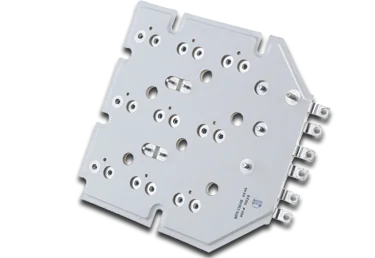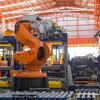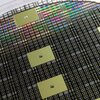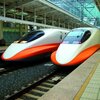Bus Bars
With over sixty years of experience in designing custom laminated bus bars, coupled with our global manufacturing and R&D footprint, Mersen has the flexibility and expertise to respond to our customers' requirements.
With over sixty years of experience in designing custom laminated bus bars, coupled with our global manufacturing and R&D footprint, Mersen has the flexibility and expertise to respond to our customers' requirements.
-
Industry Leading Bus Bar Design & Manufacturing
Benefits
Our many years of industry experience include millions of man hours working to continuously perfect our products and processes. We continue to strive to develop and deliver innovative power solutions for a variety of applications.
Mersen has extensive experience in:
- Quality Control and Quality Assurance
- Engineering and Design
- Simulation and Prototyping
- Tool and Die Design and Build
- Assembly
- Epoxy Encapsulation
- Metal Fabrication
- Metal Joining
- Die Cutting
- Laminating
- Electrostatic Powder Coating
-
Superior Quality From Design Through Manufacture
Capabilities
From the first design consultation through dock to stock shipments, Mersen provides customers with innovative power distribution solutions. You’re always assured that we’ve omitted nothing in our quest for customer satisfaction. Let us offer you the same peace of mind that thousands of other customers have enjoyed for more than 60 years. Here are just a few reasons:
State-of-the-Art Metal Fabrication
Metal Fabrication capability is a key component to producing quality product. Our state-of-the-art metal fabrication is maintained in-house and includes CNC fabricators, production punch presses ranging up to 75 tons, CNC press brakes, and various edge conditioning processes. We also offer a wide range of metal joining processes, including induction brazing, torch brazing, and soldering.
Plating Finishes
Mersen can provide almost any finish to meet your needs. Our finishing includes tin, tin-lead, nickel, copper, silver and gold. Plating under tight, laboratory-controlled conditions, we monitor and control plating thickness to required specifications. Careful data monitoring, in-process controls, and x-ray testing combine to ensure a quality finish.
Precision Manufacturing of Dielectric Components
Precision manufacturing of dielectric components is crucial in laminated bus bar production. To ensure quality, we maintain calibrated humidity and temperature-controlled conditions to store our insulation. Precision steel rule dies are used for cutting the insulation, ensuring uniformity of size to produce quality bus bars.
Properly Selected Insulation
Properly selected insulation is the key factor to a bus bar’s electrical integrity. We utilize a wide variety of dielectric materials, including Nomex, Mylar, Kapton, Epoxy-Glass, GPO, Gatex and Phenolics readily available to virtually meet any specifications. In addition to traditional sheet lamination systems, we maintain our own electrostatic powder coating department that produces a quality epoxy finish with high dielectric protection for bus bars with geometric forms, or those used in harsh environments.
Assembly and Lamination
The assembly and lamination of bus bars are controlled using sophisticated laminating systems specifically designed and manufactured for each bus bar. Hardware and interconnection devices can be added before or after the laminating and plating process.
-
What is a Laminated Bus bar?
Design Guide
A laminated bus bar is an engineered component consisting of layers of fabricated copper separated by thin dielectric materials, laminated into a unified structure. Sizes and applications range from surface-mounted bus bars the size of a fingertip to multilayer bus bars that exceed 20 feet in length. Laminated bus bar solutions are routinely used for low volumes up through tens of thousands per week.
Unique Features in Mechanical Design
The physical structure of bus bars offers unique features in mechanical design. For example, complete power distribution subsystems can also act as structural members of a total system. The proper design of bus bars depends on an application’s mechanical and electrical requirements. This section includes basic formulas and data to aid design engineers in specifying bus bars for power distribution systems. Once an outline of a bus bar has been established, specific design and manufacturing considerations will affect the cost.
Engineering Toolbox
We’ve provided basic design criteria to help you specify bus bars for your application. The information required to specify a bus bar includes: conductor material, number of conductors (including ground), dimensions (length, width and thickness), interconnection schemes, mounting configuration (if required), type of finish and choice of insulation material.
-
Why Choose a Laminated Bus Bar?
Advantages of using Bus Bars
Bus bars reduce system costs, improve reliability, increase capacitance, and eliminate wiring errors. They also lower inductance and increase capacitance. Plus, the physical structure of bus bars offers unique features in mechanical design. For example, complete power distribution subsystems can also act as structural members of a total system. Multilayer bus bars offer a structural integrity that wiring methods just can’t match.
-
-
Bus Bars Reduce System Costs
A laminated bus bar will lower manufacturing costs by decreasing assembly time as well as internal material handling costs. Various conductors are terminated at customer specified locations to eliminate the guesswork usually associated with assembly operating procedures. A reduced parts count will reduce ordering, material handling and inventory costs. -
Bus Bars Fabrication Allows Flexibility
Fabricated bus bars fit your specific needs and are customized for maximum efficiency. -
Bus Bars Improve Reliability
Laminated bus bars can help your organization build quality into processes. The reduction of wiring errors results in fewer reworks, lower service costs and lower quality costs. -
Laminated Bus Bars Increase Capacitance
Increased capacitance results in decreasing characteristic impedance. This will ultimately lead to greater effective signal suppression and noise elimination. Keeping the dielectrics thin and using dielectrics with a high relative K factor will increase capacitance.
-
-
-
Bus Bars Eliminate Wiring Errors
By replacing a standard cable harnesses with bus bars, the possibility for miss-wirings is eliminated. Wiring harnesses have high failure rates relative to bus bars, which have virtually none. These problems are very costly to repair. Adding bus bars to your systems is effective insurance. -
Bus Bars Lower Inductance
Any conductor carrying current will develop an electromagnetic field. The use of thin parallel conductors with a thin dielectric laminated together minimizes the effect of inductance on electrical circuits. Magnetic flux cancellation is maximized when opposing potentials are laminated together. Laminated bus bars have been designed to reduce the proximity effect in many semiconductor applications as well as applications that involve high electromagnetic interference (EMI) such as SiC or GaN high frequency circuits. -
Bus Bars Lower Impedance
Increasing the capacitance and reducing the inductance is a determining factor in eliminating noise. Keeping the dielectric thickness to a minimum will accomplish the highly desired low impedance. -
Bus Bars Provide Denser Packaging
The use of wide, thin conductors laminated together led to decreased space requirements. Laminated bus bars have helped decrease total system size and cost.
-
-
-
Bus Bars Provide Wider Variety of Interconnection Methods
The flexibility of bus bars have allowed an unlimited number of interconnection styles to choose from. Bushings, embossments, and faston® tabs are most commonly used. Wire harnesses, solderable connectors, and pressed-in fittings are also integrated into the design, making a bus bar compatible with virtually any type of interface. -
Bus Bars Improve Thermal Characteristics
The wide, thin conductors are favorable to allowing better airflow in systems. As package sizes decrease, the cost of removing heat from systems is greatly increased. A bus bar not only reduces the overall size of system package required, but it can also improve airflow with its sleek design.
-
-
Thermal & Electrical Simulations
-
Temperature Rise Simulations
MERSEN application engineers can conduct temperature rise simulation on the bus bar prototypes. This will ensure the most thermal efficient busbar design will go to production, providing our customers optimum product performance and lowest heat dissipation. As standard practice, our design takes care of the capacitor thermal limitations by preventing it from reaching excessive overheating which in turn may dramatically affect its life-time expectancy. -
Electrical Current Flow Simulations
In addition to temperature rise simulations, prototype pieces can also be subjected to electrical current flow simulations. MERSEN has perfected pre-design rules over years of experience and can provide a very efficient design from the get go. Further simulation runs can in turn perfect the final design in order to provide the final product with best electrical performance. -
High Frequency Skin Effect
Because of skin effect phenomena, inductance and resistance are dependent on frequency. With the emergence of high-frequency wide-bandgap technologies, currents tend to flow only on the surface of the conductor. Therefore the depth of penetration of the electromagnetic energy determines the effective conducting volume. -
Semiconductor Communication Loss
When dealing with SiC, GaN or any high-speed commutation electronics applications, Mersen will achieve the lowest the lowest inductance path design to reduce semiconductor commutation losses.
-
-
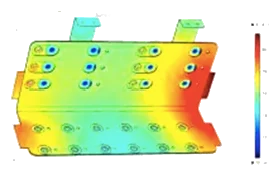
-
Integrated Architecture
Power Electronics
Mersen has gathered together the latest technical innovations illustrating the Integrated Architecture approach that can be offered to our inverter manufacturer clients.
Mersen’s integrated architecture approach helps inverter designers save time by optimizing the selection of key components, benefiting from a solution that is pre-designed for their specific application. Busbar, fuses, cooling, gate-drivers, capacitors, and connectors can now be optimally designed together, in one step to meet electrical, mechanical and thermal challenges of the system.
-
Benefits
Mersen’s power electronic bundling solution helps maximize system performance, lower total costs, and reduce time to market. Our integrated architecture comprises:
- Laminated Bus Bar:
As a superior alternative to wiring option, laminated insulated bus bar provides electrical and mechanical connection between various components. Laminated bus bar limits parasitic inductance and reduces assembly time, leading to an improvement of the overall power converter reliability, performance, and efficiency while minimizing assembly costs - Cooling Systems:
Mersen integrates its extensive cooling expertise and patented heatsink technology into semiconductor applications to make them more efficient, reliable, and profitable - Fast-acting Fuses:
Mersen Semiconductor protection fuses are used to protect against over-current conditions in power electronic equipment.

- Laminated Bus Bar:
-
Ask an expert
The right design for your application
Mersen’s dedicated power electronics team is available to customize a solution for you. Make Mersen your power electronics protection partner, and you’ll discover a powerful ally that can help you protect your people and equipment.
-
Why Partner with Mersen?
-
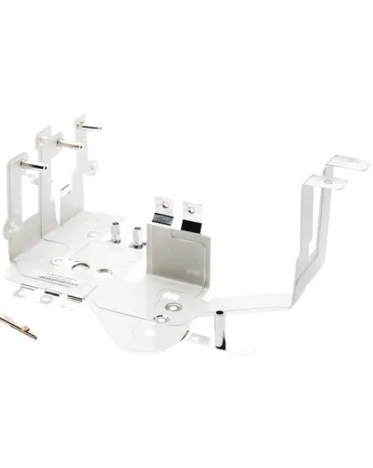
Extensive Experience
over sixty years of experience
With over sixty years of experience in designing laminated bus bars and complete in-house manufacturing capability, we have the flexibility and expertise to respond to our customers’ requirements. Our many years of industry experience and expertise include millions of man hours working to continuously perfect our products. We continue to strive to develop and deliver innovative power solutions for a variety of applications.
-
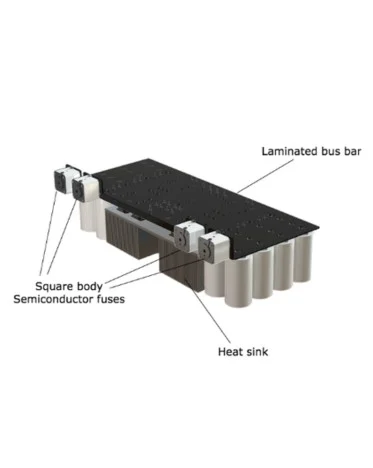
Customized Electrical Protection Solutions
Power Electronics
Combine MERSEN square body semiconductor protection fuses with MERSEN’s Thermal protection and laminated bus bar offerings for an optimized solution to support your power electronics design whatever the semiconductor technology (Silicon, Silicon Carbide or Gallium Nitride). As a design partner with extensive application and product expertise, MERSEN is able to maximize system performance, lower total costs, and reduce time to market. Our dedicated power electronics team is available to customize a solution for you.
-
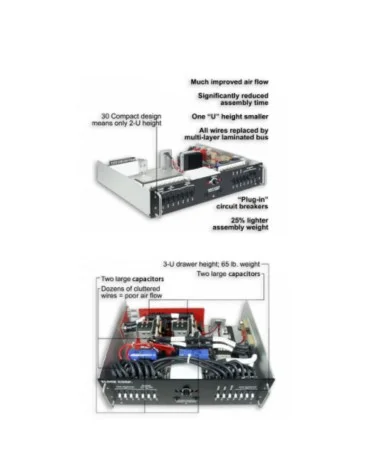
Value Add Solutions
Multilayer bus bars
Multilayer bus bars offer a structural integrity that wiring methods just can’t match. Mersen’s Value Added bus bar designs incorporate a variety of components built right in. Each one is safety tested and certified, all designed to help simplify your life at the system assembly level.
-
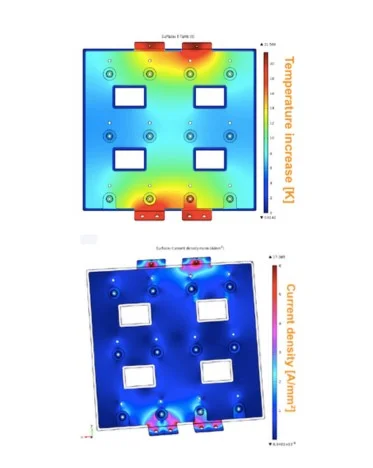
Simulation and Analysis
bus bar prototyping
Each and every bus bar prototype can go under Temperature Rise Simulation and Current Flow Analysis testing. These simulations allow our engineers to design the most reliable and efficient bus bar layouts.
-
